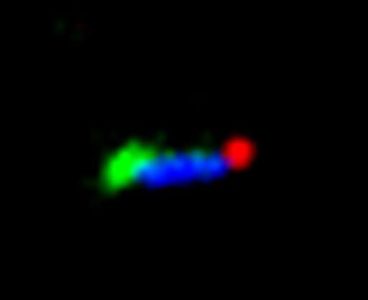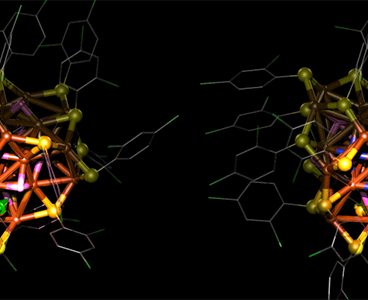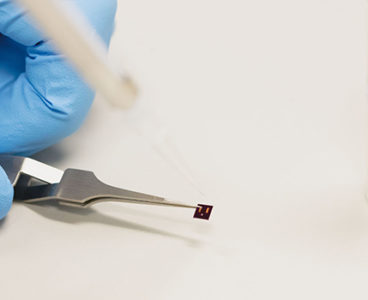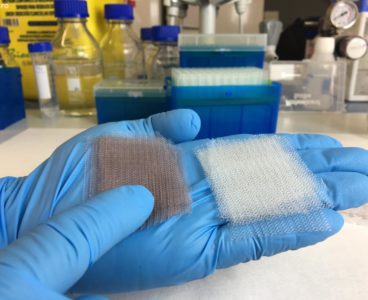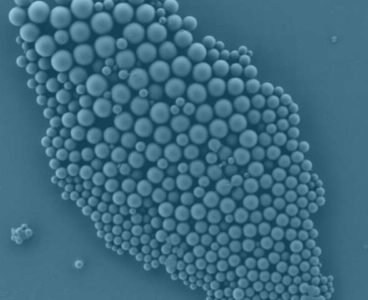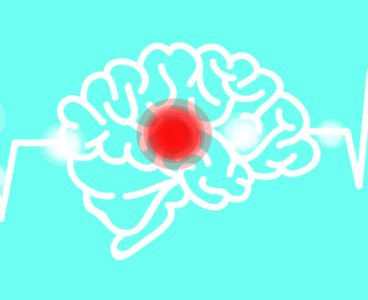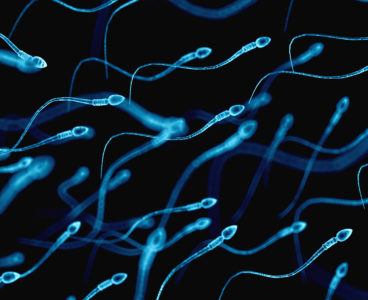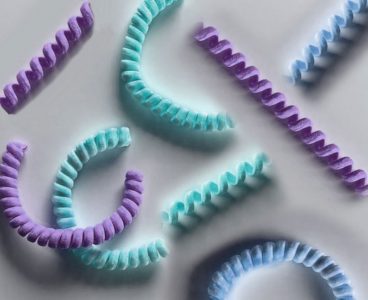DNA assembled into nanostructures such as tubes and origami-inspired shapes could someday find applications ranging from DNA computers to nanomedicine. However, these intriguing structures don’t persist long in biological environments because of enzymes called nucleases that degrade DNA. Now, researchers have designed DNA nanostructures that can heal themselves in serum. They report their results in…
Carbon Nanotubes Grown with the Help of Pantry Staples
Baking soda, table salt, and detergent are surprisingly effective ingredients for cooking up carbon nanotubes, researchers at MIT have found. In a study published in the journal Angewandte Chemie, the team reports that sodium-containing compounds found in common household ingredients are able to catalyze the growth of carbon nanotubes, or CNTs, at much lower temperatures…
Researchers Uncover How a Nanocatalyst Works at the Atomic Level
The researchers of the Nanoscience Center (NSC) at the University of Jyväskylä, Finland, and in the Xiamen University, China, have discovered how copper particles at the nanometre scale operate in modifying a carbon-oxygen bond when ketone molecules turn into alcohol molecules. Modification of the carbon-oxygen and carbon-carbon bonds found in organic molecules is an important…
Researchers Create Strong, Sustainable Solution for Passive Cooling
What if the wood your house was made of could save your electricity bill? In the race to save energy, using a passive cooling method that requires no electricity and is built right into your house could save even chilly areas of the U.S. some cash. Now, researchers at the University of Maryland and the…
Bending the Norm on Nanowires for Durability
New methods of arranging silver nanowires make them more durable, shows a study by KAUST. These nanowires form flexible, transparent conductive layers that can be used for improved solar cells, strain sensors and next-generation mobile phones. Applying nanotechnology in electronic devices requires rigorous testing of individual tiny components to ensure they will stand up to…
Light, Nanotechnology Prevent Medical Implant Bacterial Infections
Invented approximately 50 years ago, surgical medical meshes have become key elements in the recovery procedures of damaged-tissue surgeries, the most common being hernia repair. When implanted within the tissue of the patient, the flexible and conformable design of these meshes helps hold muscles tight and allows patients to recover much faster than through the…
For the First Time, Biobased Nanocarriers Cure Plant Diseases
Plant diseases, though a normal part of nature, can have disastrous effects in agriculture. They reduce food for people and revenues in rural areas. In the worst cases they result in hunger and starvation, as many famines in history show. About 16 percent of all crops are lost to plant diseases each year across the…
Big Energy Savings For Tiny Machines
Inside all of us are trillions of tiny molecular nanomachines that perform a variety of tasks necessary to keep us alive. In a ground-breaking study, a team led by SFU physics professor David Sivak demonstrated for the first time a strategy for manipulating these machines to maximize efficiency and conserve energy. The breakthrough could have…
Hard Carbon Nanofiber Aerogel becomes Superelastic
Conductive and compressible carbon aerogels are useful in a variety of applications. In recent decades, carbon aerogels have been widely explored by using graphitic carbons and soft carbons, which show advantages in superelasticity. These elastic aerogels usually have delicate microstructures with good fatigue resistance but ultralow strength. Hard carbons demonstrate great advantages in mechanical strength…
Nanoscale Sculpturing Makes for Unusual Packing of Nanocubes
From the ancient pyramids to modern buildings, various three-dimensional (3-D) structures have been formed by packing shaped objects together. At the macroscale, the shape of objects is fixed and thus dictates how they can be arranged. For example, bricks attached by mortar retain their elongated rectangular shape. But at the nanoscale, the shape of objects…
Biological Movement Designed on the Nanometer Scale
Synthetic proteins have been created that move in response to their environment in predictable and tunable ways. These motile molecules were designed from scratch on computers, then produced inside living cells. To function, natural proteins often shift their shapes in precise ways. For example, the blood protein hemoglobin must flex as it binds to and…
Brittle Materials Join Up for Flexible Electronics
Mixing two brittle materials to make something flexible defies common sense, but Rice University scientists have done just that to make a novel dielectric. Dielectrics are the polarized insulators in batteries and other devices that separate positive and negative electrodes. Without them, there are no electronic devices. The most common dielectrics contain brittle metal oxides…
Gut Microbiota Affected by Common Food Additive
Experts call for better regulation of a common additive in foods and medicine, as research reveals it can impact the gut microbiota and could lead to inflammatory bowel diseases or colorectal cancer. University of Sydney research provides new evidence that nanoparticles, which are present in many food items, may have a substantial and harmful influence…
Soft Nanoparticles Popped Open Using Sound Waves
Ultrasound has long been an important tool for medical imaging. Recently, medical researchers have demonstrated that focused ultrasound waves can also improve the delivery of therapeutic agents such as drugs and genetic material. The waves form bubbles that make cell membranes—as well as synthetic membranes enclosing drug-carrying vesicles—more permeable. However, the bubble-membrane interaction is not…
Gold Helps Create ‘Impossible’ Nano-sized Protein Cages
Researchers from an international collaboration have succeeded in creating a “protein cage”—a nanoscale structure that could be used to deliver drugs to specific places of the body—that can be readily assembled and disassembled but that is also extremely durable, withstanding boiling and other extreme conditions. They did this by exploring geometries not found in nature,…
Nanoparticles Help Brain Recover after Stroke
Tiny selenium particles could have a therapeutic effect on ischemic brain strokes by promoting the recovery of brain damage. Pharmacologists, including Alireza Mashaghi from the Leiden Academic Centre for Drug Research discovered that selenium nanoparticles inhibit molecular mechanisms that are responsible for the loss of brain cells after a stroke. The results were published in…
A New Approach to Data Storage
Researchers at Johannes Gutenberg University Mainz (JGU) have succeeded in developing a key constituent of a novel unconventional computing concept. This constituent employs the same magnetic structures that are being researched in connection with storing electronic data on shift registers known as racetracks. In this, researchers investigate so-called skyrmions, which are magnetic vortex-like structures, as…
Sperm Sensor Molecule May Aid Development of Contraceptives, Fertility Treatment
Sperm start their sprint to the ovum when they detect changes in the environment through a series of calcium channels arranged like racing stripes on their tails. A team of Yale researchers has identified a key molecule that coordinates the opening and closing of these channels, a process that activates sperm and helps guides them…
First Stand-alone Contact Lens Contains a Flexible Micro Battery
The Optics Department at IMT Atlantique is headed by Professor Jean-Louis de Bougrenet de la Tocnaye and the Flexible Electronics Department at the Centre Microélectronique de Provence Georges Charpak (Mines Saint Etienne) is headed by Professor Thierry Djenizian. The two departments are currently working together to design an oculometer embedded in a scleral contact lens.…
Liquid Crystals in Nanopores Create Surprisingly Large Negative Pressure
Negative pressure governs not only the Universe or the quantum vacuum. This phenomenon, although of a different nature, appears also in liquid crystals confined in nanopores. At the Institute of Nuclear Physics of the Polish Academy of Sciences in Cracow, a method has been presented that for the first time makes it possible to estimate…
Nanomaterial Helps Heal Damage after a Heart Attack
For people who survive a heart attack, the days immediately following the event are critical for their longevity and long-term healing of the heart’s tissue. Now researchers at Northwestern University and University of California, San Diego (UC San Diego) have designed a minimally invasive platform to deliver a nanomaterial that turns the body’s inflammatory response…
Carbon Nanotubes Could Potentially Cool Electronic Circuits
The use of solid-state refrigerators to cool appliances and electronic devices is a possible technological application for a theoretical study conducted at the University of Campinas (UNICAMP) in São Paulo State, Brazil. Although this application is not considered in the study, which was based on computer simulations, such applications are on the horizon and could…
Nanosized Container with Photoswitches Jettisons Cargo upon Irradiation
Researchers at Tokyo Tech have developed a nanosized container bearing photoswitches that takes up hydrophobic compounds of various size and shape in water and subsequently releases them quantitatively by non-invasive light stimulus. The installed switches allow reusing of the container after successful release of the cargo. The novel system represents a versatile platform for future…
Stretchy, Protective Artificial Tissue Made from ‘Nanofiber Yarn’
The human body is held together by an intricate cable system of tendons and muscles, engineered by nature to be tough and highly stretchable. An injury to any of these tissues, particularly in a major joint like the shoulder or knee, can require surgical repairs and weeks of limited mobility to fully heal. Now MIT…

